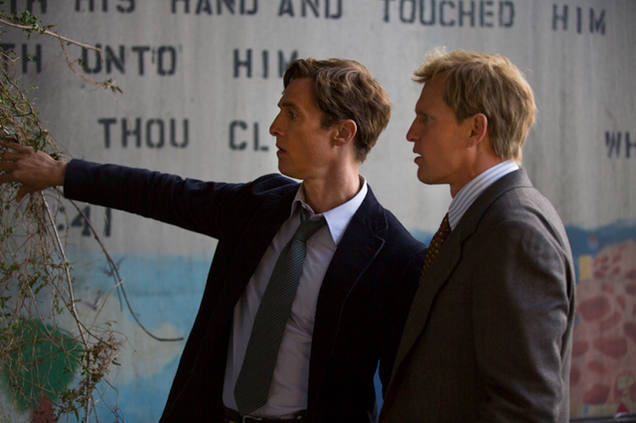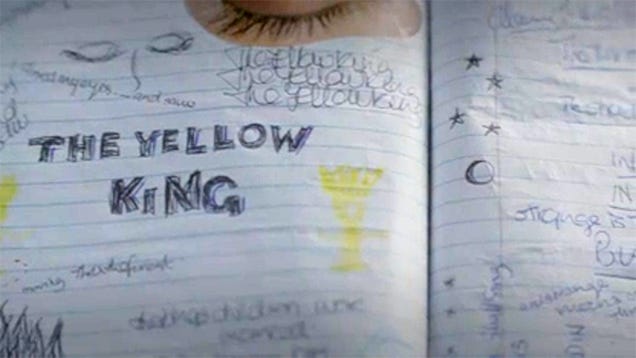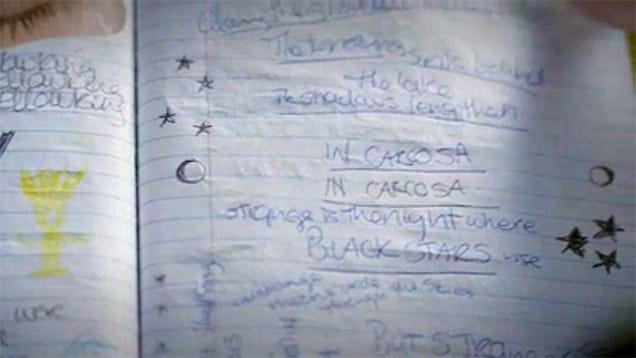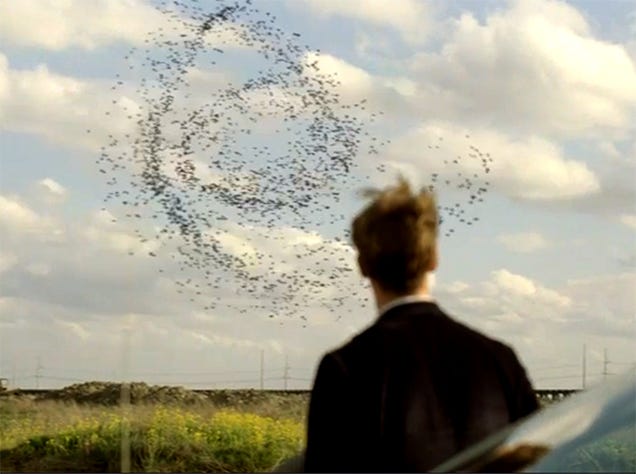The One Literary Reference You Must Know to Appreciate True Detective
 1Expand
1Expand
Two episodes into the series, True Detective dropped a reference to one of the strangest, most compelling tales in the canon of weird fiction: Robert W. Chambers' The King in Yellow,
a collection of short stories published in 1895. Knowing this book is
key to understanding the dark mystery at the heart of this series.
This
collection of stories has influenced writers from H.P. Lovecraft and
Raymond Chandler, to Robert Heinlein, Grant Morrison, Neil Gaiman and
George R. R. Martin. The King in Yellow and his legendary city of Carcosa may be the most famous character and setting you've never heard of.
In
fact, the more of the show you watch, and the more carefully you pay
attention, you'll find a number of Easter eggs aimed squarely at
hardcore fans of the weird fiction genre. I'll touch on a few of the
more prominent ones, but I have a feeling the rest of the series will be
a bonanza for true detectives of strange fiction.
Camilla: You, sir, should unmask.Stranger: Indeed?Cassilda: Indeed it's time. We all have laid aside disguise but you.Stranger: I wear no mask.Camilla: (Terrified, aside to Cassilda.) No mask? No mask!—The King in Yellow: Act I, Scene 2
The King in Yellow
is a fictional play within a collection of short stories—a
metafictional dramatic work that brings despair, depravity, and insanity
to anyone who reads it or sees it performed. Chambers inserts only a
few selected scenes from the play into his story collection, and all of
them are from the first act. This act, we are told, is a bit of a
honeypot, luring readers into the cursed text. If they read even the
first few words of Act II they are driven insane by the revelation of
horrible, decadent, incomprehensible truths about the universe.
Anyone
familiar with Lovecraft's "cosmic horrors" should see the thematic
similarity. For his unfortunate protagonists, the ultimate truths of the
universe are too much for their overloaded minds to handle. It should
not be surprising that Lovecraft incorporated Chambers's The King in Yellow
into his overarching Cthulhu mythos, embellishing the elements of the
story and adding the fictitious play to his growing bookshelf of equally
fictional mythos tomes.
Songs that the Hyades shall sing,Where flap the tatters of the King,Must die unheard inDim Carcosa.—Cassilda's Song in The King in Yellow, Act I, Scene II
For
many fans of weird fiction, the surprising appearance of this
madness-inducing play into what ostensibly appeared to be just another
police procedural was a bolt of lightning. Suddenly, the tone of the
show changed completely, signaling the descent into a particular brand
of horror rarely (if ever) seen on television. The first mention of the
play comes in episode two when Rust Cohle, the cynical, nihilistic
detective played by Matthew McConaughey, finds the journal of a young
former prostitute, Dora Lange, who has been ritualistically murdered.
"I closed my eyes and saw the King in Yellow moving through the forest," Cohle reads aloud from her journal. "The King's children are marked. They became his angels."
"I closed my eyes and saw the King in Yellow moving through the forest," Cohle reads aloud from her journal. "The King's children are marked. They became his angels."

The journal pages flash briefly on the screen. Lines from Chambers's play have been copied verbatim into the notebook.

Along the shore the cloud waves break,The twin suns sink behind the lake,The shadows lengthenIn CarcosaStrange is the night where the black stars rise,And strange moons circle through the skies,But stranger still isLost Carcosa—The King in Yellow, Act I, Scene II
Note
the black stars, which become recurring symbols in the series. Black
stars also appear as tattoos on the neck of the character of Carla, who
first alerts Cohle and Hart to Dori's involvement with a strange
"church."
But
the weirdness gets even thicker in episode three. A revivalist tent
preacher has the unusual name of Joel Theriot, which is one letter away
from the name claimed by famed occultist Aleister Crowley, who referred
to himself as Master Therion, aka The Beast 666. And I had to pause the
show when I watched Theriot lower his head and make the sign of the
cross on his chest—because he does it backwards (right to left, instead
of left to right). Given the meticulous layering of clues and symbols
throughout the other episodes, my guess is that was intentional.
Later
in the episode, our detectives interrogate a convict named Charlie in a
bare, concrete room, attempting to get information about their prime
suspect, Reggie Ledoux, aka The Tall Man. Charlie had been a former
cellmate of Ledoux's. Charlie was privy to some of the Tall Man's
peculiar stories, which he relates to the detectives:
He said that there's this place down south where all these rich men go to, uh, devil worship. He said that, uh, they—they sacrifice kids and whatnot. Women and children all got—all got murdered there and, um, something about someplace called Carcosa and the Yellow King. He said there's all these, like, old stones out in the woods, people go to, like, worship. He said there's just so much good killin' down there. Reggie's got this brand on his back, like a spiral. He says that's their sign.
The
spiral was found painted (tattooed?) on the murdered Dora's back, as
well as on another victim Cohle discovered in the police archives. And
in a recursive layering of clues, we've seen the spiral in another
unusual sequence in episode two. As Cohle observes a group of birds
outside of a burned church, they swirl and coalesce into the identical
spiral formation before flying away. It's a chilling moment that has
already been dissected by many viewers.
The
idea of ancient standing stones as the scene of bizarre pagan rites and
atavistic sacrifices is a common trope of weird fiction, too, and was
employed by authors as far back as Arthur Machen and Lovecraft ("The
Dunwich Horror"), up through Stephen King (in his short story "N"). I
used such a scene in my own novel, Blackwater Lights.
And
those are only a few of the Easter eggs and symbols embedded in this
clever and meticulously constructed television drama. Take note, for
instance, of the regular use of yellow—in Cohle's dim, depressing
apartment and the smoky haze at the illegal warehouse rave. Yellow is
visually linked to insanity, mental collapse, and decadence—another
explicit echo of Chambers's iconic mythology.
But
where, one might wonder, is this all going? Is this just writer Nic
Pizzolatto dropping nods to his favorite authors and their fans? Some
critics have dismissed the idea that the show is moving into the realm
of the supernatural, but I have little doubt that it is going to only
get much weirder and much, much darker. The clues are all there for
those with eyes to see.
Why The King in Yellow?
I think it's obvious, and I'll go out on a limb and say the season will
continue with detectives Cohle and Hart edging closer to the abyss of
what Lovecraft termed "cosmic fear," which he defined as:
A certain atmosphere of breathless and unexplainable dread of outer, unknown forces . . . a hint, expressed with a seriousness and portentousness becoming its subject, of that most terrible conception of the human brain—a malign and particular suspension or defeat of those fixed laws of Nature which are our only safeguard against the assaults of chaos and the daemons of unplumbed space.
In a revealing interview with the The Wall Street Journal,
Pizzolatto discusses his love of existential horror and its most
prominent authors, from Chambers and Lovecraft to modern masters of the
weird Laird Barron and Thomas Ligotti:
Their fictional visions of cosmic despair were articulating the same things as certain nihilist and pessimist philosophers, but with more poetry and art and vision . . . It's important for us to confront the potential of the true abyss. . . .
Clearly,
the present-day Cohle, with his glazed, vacant eyes and brutally
nihilistic philosophy, is someone who has experienced the chaos and
daemons lurking just over the edge of the interminable abyss. He
explains his philosophy in his interview with the two current-day
detectives:
You, yourself, this whole big drama, it was never anything but a jerry-rig of presumption and dumb will and you could just let go, finally know that you didn't have to hold on so tight. To realize that all your life, you know, all you love, all you hate, all your memory, all your pain—it was all the same thing. It was all the same dream, a dream you had inside a locked room, a dream about being a person. And like a lot of dreams . . . there's a monster at the end of it.
Cohle has seen the monster. I suspect we will, too.
Michael M. Hughes lives in Baltimore with his wife and two daughters. He writes fiction and nonfiction, and his debut novel, Blackwater Lights,
was released by Hydra (Random House) in 2013. He is currently at work
on the sequel. When he's not writing, Hughes performs as a mentalist
(psychic entertainer) and speaks on Fortean and paranormal topics.



No comments:
Post a Comment